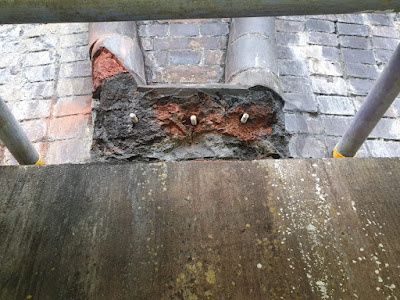Br. 12 – STANWAY VIADUCT REPAIRS
Blog covering the entire 10-week contract.
Unfortunately, this our largest structure, required a large quantity of rather uninteresting repair works and, naturally there is a vast amount of repetition involved!! Not too exciting!!
 |
| Stanway viaduct, with scaffolding. |
Despite that, the GWR Trust kindly agreed that they would fund these very important works on what is a really iconic structure.
There are 4 main types of work required. These are: -
1. Corner re-casing. The problem is that vertical cracks appear close to the corner on both faces of a pier, and as happened to pier 8 in April 2019 (LH photo), the entire corner about 3M high x app 250 to 350 mm along both faces fell off.
This was repaired in March 2021. The work involves removing the cracked bricks and toothing out the brickwork to enable new bricks to be inserted (see RH photo).
The corners are then strengthened by the building in of 5mm diam stainless steel twisted helical bars into the joints. These wrap around the corners and extend along both faces to tie the corner into the sound face brickwork alongside.
 |
| Special repair of bullnose feature, from above. |
2. Replacement of cracked, frost damaged, or missing bricks. This is fairly obvious as to what is required. A frequent item is missing bricks from the holes where the temporary curved formwork was supported during the building of the arches. (photo below).
 |
| Missing bricks |
3. Hollow brickwork. This is where the bonding between facing brickwork and the inner core brickwork has failed with linking bricks cracking right through. The solution is to drill at an angle into the brickwork, through to the inner sound brickwork and install stainless steel anchors which are grouted into place.
4. Pointing. This is a very common problem on older structures and the old crumbling mortar has to be cut out and new rammed in.
Repointing work on various parts of the arches.
The work started in mid-September 2022, and, as the ground gets very boggy and soft, the first thing was to construct a main access route onto site was created using very thick heavy duty interlocking plastic mats (see photos below).
 |
| Interlocking mats. |
Naturally, as the work extended to all faces of the piers, including the spandrels (the high-level side walls above the piers/arches) very extensive scaffolding was required. (Photos below).
 |
| Extensive scaffolding |
 |
| Spandrel above pier 7. |
The work started with pier 7 and then 6 and 5, with the spandrels above, following. Some work was also done to the lower parts of the arches, just above the piers.
 |
| Repointing work done. |
The extent of the work was based on the 228-page report received from the very detailed examination done in October 2018. Most of this was done by men working from the parapet, suspended by ropes (photo below).
(1).jpg) |
| Abseiling to examine the state of the structure. |
With the continuing deterioration in the subsequent 4 years and with the somewhat limited accessibility issue, an additional 15% to 20% of additional items have been found and dealt with. Our Chartered Engineer volunteer Peter Lewis, who joined early last year, did a magnificent job of surveying and identifying the extent of the hew work, in conjunction with the contractors.
Because of the scaffolding and the localised nature of the work, taking useful photos has been difficult, but a small selection is included.
All work on site, including the removal of the scaffolding, was completed before Christmas. The temporary road mats will be removed in the first week of 2023.
We are grateful to the local tenant farmer, who kindly moved the grazing horses into an adjacent field for the duration of the works, and to Lord Wemyss for permission to work on his land.
Photos have been provided by me, John Fancote. Peter Lewis and the contractors site manager – Mark Williams.
Prepared by John Balderstone - Structures Engineer GWSR. 2nd January 2023.







.jpg)
Hi John. Happy New Year to you. A very informative posting of this work. How much similar work is required to bring the viaduct up to current standards?
ReplyDeleteLooking forward to the next posting....hopefully not too loooooong to wait!
Andy protherough
I found this report very interesting and reassuring for its longer term future that the Viaduct has received such detailed examination and repair.
ReplyDeleteMany thanks for taking the time to produce this update for us all, and the same for all those providing all the other infrastructure blogs
Thanks Andy, There is similar work to do on all of the piers and arches, but the more important job is to waterproof the deck properly. We only had time and money to do a partial drainage upgrade 3 years ago. The original construction never had proper cross falls to the central drainage pits as shown on the drawings, so the water soaked into the brickwork and that is what has caused the worst of the damage
ReplyDeleteVery many thanks for taking such detailed pictures and giving us a clear picture of this essential work. These blogs make really interesting reading and show the professional approach to the many aspects of infrastructure maintenance.
ReplyDeleteRon Hayhurst